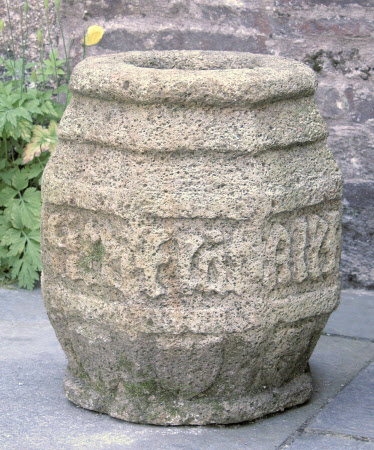Cresset stone, of barrel shape in octagonal form; carved with inscription and decorative icons.
Alexander Champernowne (d.1441)
Category
Art / Sculpture
Date
1382 - 1441
Materials
Roborough stone
Order this imageCollection
Cotehele, Cornwall
NT 348236
Caption
Cresset stones were used to illuminate churchyards. They would be filled with oil or pitch, upon which a wick was floated to provide a light to churchgoers. This one is inscribed to Alexander Champernowne of Bere Ferrers (1382-1441). It probably passed to Edgcumbe ownership through a marriage dowry in the late 18th-C (Richard 2nd Earl and Sophia Hobart of Blickling, Norfolk, daughter of 2nd Earl of Buckinghamshire). It is a curious irony that the land at Bere Ferrers should end up in Edgcumbe ownership. In 1480, Richard Edgcumbe I and Roger Willoughby de Broke (Champernowne’s son-in-law) were engaged in a vicious feud. Dr Jo Mattingly writes as part of a chronology forming an appendix to the 2004 Historic Building Analysis: May 1, 1480: Willoughby at Cotehele and ‘shote arrowes’ at Richard I’s servants, ‘brake dyvers dores’ and threatened to set fire to house. He also drew his sword and threatened Edgcumbe’s children, and servant John Dowrygge, saying ‘he would cut off their cries’ if they didn’t tell him where Richard I was. Richard I also complained that Willoughby’s servants had stolen goods including bedding, blankets, shirts, bows, a hat and a tippet, a hunting horn, brass pots and pans, a broche (spit), a pair of hose, corn and wheat etc at Cotehele and that he was forced to lie daily and nightly in the woods. Later Willoughby & Richard I became allies (Edgcumbe 1888, 12).
Summary
Cresset stone. Of barrel shape in octagonal form; carved with inscription and decorative icons. According to J. H. Adams, writing in Cornwall Archaeology in (year?), the inscription reads: "ALEXANDER CHAMPNON ME FIER(I) FECIT. The only really serious difficulty lies in the last word but one which appears to be FIET but must, I think, be intended for FIERI, the 'I' being omitted either by accident or miscalculation of the space needed. The badly formed 'R' may be due to the difficult nature of the stone."
Marks and inscriptions
Alexander Champnon me fier (i) fecit
Makers and roles
Alexander Champernowne (d.1441), commissioner

